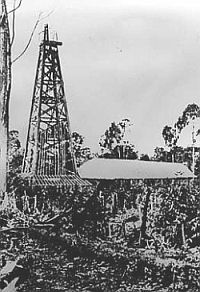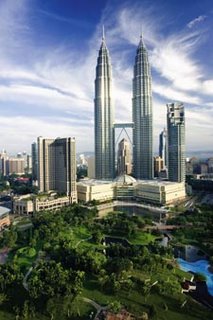KUALA LUMPUR: Petroliam Nasional Bhd (Petronas) reported yet another year of record profit as crude oil prices and sales of liquefied natural gas (LNG) continued to rise.
The national oil company recorded a 22.6% increase in net profit at the group level to RM43.6bil for its financial year ended March 31, 2006 as revenue rose 21.8% to RM166.9bil but president and CEO Tan Sri Hassan Marican said spiralling cost, the shortage of human capital and ongoing gas subsidies were concerns.
“Cost to develop and explore has gone up. It has become another challenge, coupled with the shortage of human resources around the world,'' he told the media at the release of Petronas' full-year financial results.
| |
Tan Sri Hassan Marican at the press conference. |
Petroleum products, such as refined products, was the biggest contributor to Petronas' revenue last year, bringing in RM55.6bil of the overall revenue of RM166.9bil. This was followed by crude oil, LNG and petrochemical products.
“We are able to achieve these results due to the high reliability of our plants,'' Hassan said.
Pre-tax profit for the year rose 21% to RM70.2bil.
Petronas said 58.4% of group revenue, which had been growing at a compounded annual rate of 26.3% over the past five years, came from manufacturing activities. Its domestic manufacturing revenue constituted 27.8% of the manufacturing sector's contribution to Gross Domestic Product.
Hassan said that percentage would have been much higher if LNG activity was included under manufacturing instead of mining.
Exports accounted for RM73.6bil of total revenue. Total shareholders' funds and liabilities jumped to RM269.2bil from RM239.1bil and the group's gearing ratio dropped to 0.16 times from 0.22 times a year earlier.
Total debt was RM43.9bil with the majority of it in US dollars and payable over the next 10 years. Petronas has RM93.1bil in cash and investments compared with RM75.2bil a year earlier.
| |
A Petronas oil rig |
Budgeted capex for its 2007 financial year was RM27.7bil, of which RM19.2bil was for the domestic market. Of the total amount, 48% was for exploration and production and 26.1% was for logistics and maritime, or for subsidiary MISC Bhd.
Total capex in 2006 was RM18.5bil and the majority of that was contributed by production sharing contract partners in Malaysia.
Comparing financial ratios of Petronas with other oil giants, Hassan said its pre-tax profit margin and return on average capital employed were much better than what the other majors were achieving.
He added that the return on total assets at 26% was lower than some of the majors but if property assets were taken out, the ROA would be about 35%.
Petronas also said that as at Jan 1 2006, total reserves in Malaysia amounted to 19.91 billion barrels of oil equivalent, a 2.8% increase from 2005.
| |














